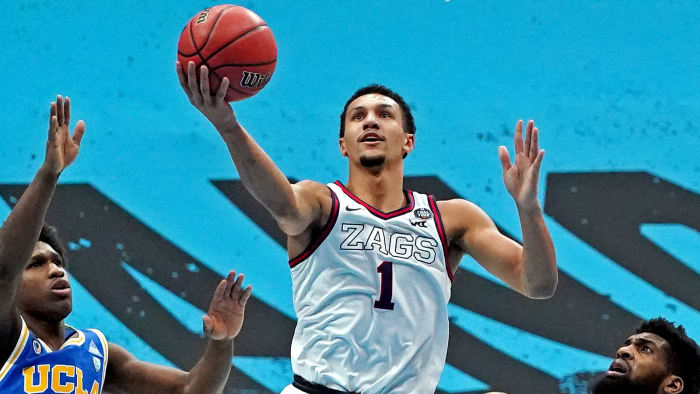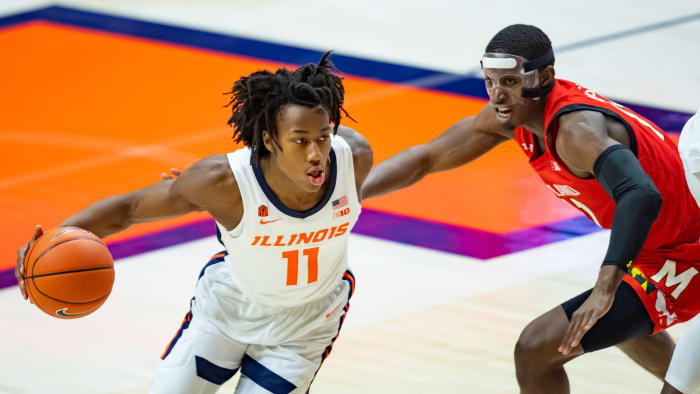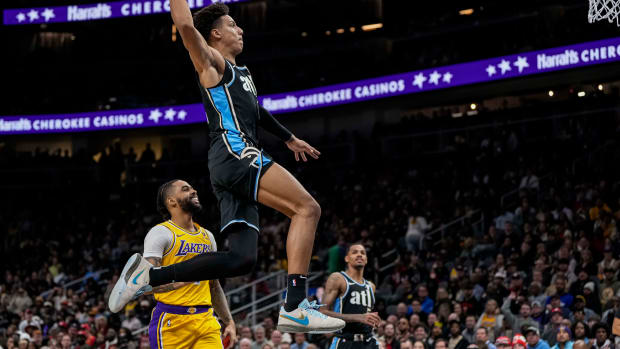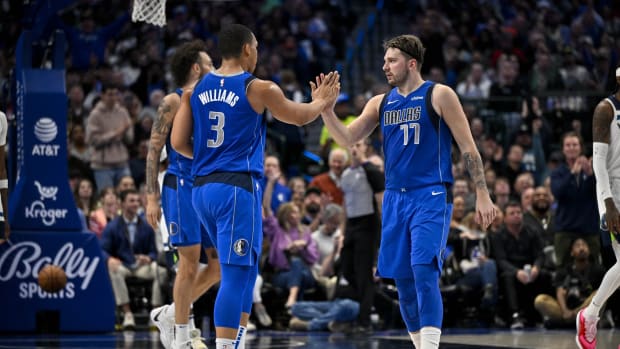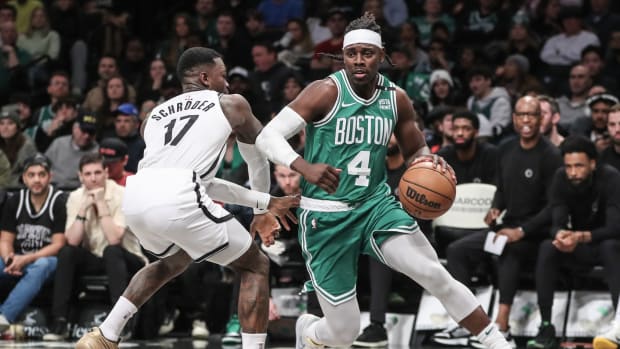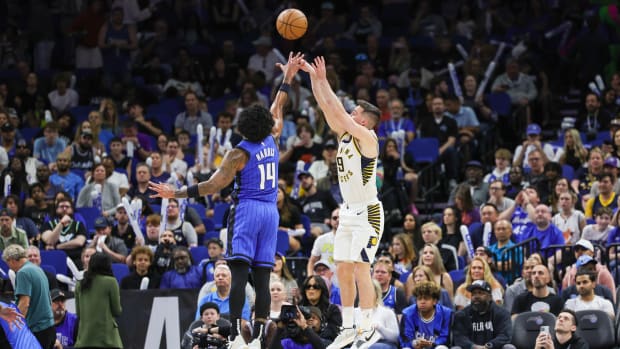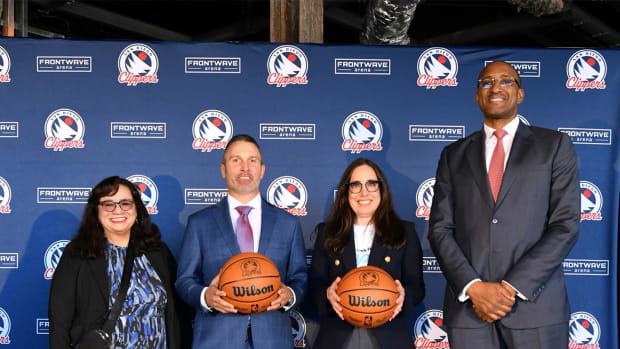NBA Mock Draft: Latest Projections After March Madness
With March Madness in the rearview and players declaring left and right for the draft, it’s a good time to make sense of the whole puzzle. I spent pretty much the entire month of March in Indianapolis at the men's NCAA tournament, where I was able to get eyes on a wide range of prospects, check in with scouts and get a better feel for where things stand, as we move toward the scheduled July 29 draft date.
The NCAA has granted seniors an extra year of eligibility for next season, which, along with players having the ability to transfer and play immediately, has thrown a bit of a wrinkle into the whole process. From the NBA’s perspective, top prospects have already separated themselves for the most part, but there will be ongoing roster gymnastics at the college level for most of the spring as players make decisions and schools are forced to fill scholarships or get left in the dust.
The NBA set a May 30 deadline for players to officially enter the draft, with the draft lottery set for June 22 and the NBA’s combine scheduled for June 21–27. The NCAA’s withdrawal date for players to return and keep their eligibility has traditionally been 10 days after the combine. While not official yet, most of the industry is operating as if July 7 will be that date.
As always, this mock attempts to project what the draft might look like on a given day, and is based primarily off intel gathered over the course of the season, whereas SI’s Big Board (which is also due for an update) is meant more as an objective ranking of prospects.
Draft sequence based on the NBA standings entering April 5.
1. Timberwolves: Cade Cunningham, G, Oklahoma State
Height: 6' 8" | Weight: 220 | Age: 19 | Freshman
Conversations around the NBA surrounding the No. 1 pick picked up over the course of the NCAA tournament, with Evan Mobley and Jalen Suggs leading their teams on deep March runs. Cunningham and Oklahoma State bowed out in the second round, but the way the team outpaced expectations all season stands as a testament to his positive impact. The top of this draft is rife with quality, and the margins feel narrow enough that there may be teams that prefer Mobley or Suggs. But Cunningham’s body of work holds up well, and his versatile skill set and positionless mentality as a 6' 8" playmaker can be transposed onto almost any roster and alongside whatever a team already has in place. His intangibles are rare, his skills continue to sharpen and he has the goods to be plenty effective, despite some long-standing trouble finishing in traffic.
Through no fault of his own, Cunningham is less of a no-brainer top prospect than he was six months ago. But he remains the favorite, and projects as an immediate impact piece wherever he lands. Odds are Minnesota would happily walk away with any of the top three prospects, but adding Cunningham to a roster that could badly use a bigger wing makes a lot of sense. His unselfishness and shooting ability would go a long way for the Timberwolves, and would allow him to fit neatly with Anthony Edwards and D’Angelo Russell on the perimeter.
2. Rockets: Evan Mobley, F/C, USC
Height: 7' 0" | Weight: 215 | Age: 19 | Freshman
In the eyes of some scouts, Mobley has inched closer to being a viable 1B to Cunningham’s 1A, on the heels of a strong freshman season that made USC nationally relevant. He’s one of the best rim-protecting prospects to come around in some time, with exceptional length and instincts and good mobility, and combines that with legitimate offensive upside due to his soft touch, passing skills and unselfish mentality. Mobley spurred a run to the Elite Eight with vast defensive impact, making the most of a useful platform with performances that spoke to his competitive mettle. It should be harder for anyone still nitpicking his motor and toughness to make that argument. And while he’s something short of an alpha dog, Mobley has the goods to supply a franchise with winning backbone and schematic flexibility in a way that most centers don’t.
There’s an outside chance Mobley goes No. 1, depending on which team holds the pick. At a similar stage he compares favorably to recent early-choice bigs like Deandre Ayton, Jaren Jackson and James Wiseman. The high defensive floor and intriguing offensive ceiling combine to make him a unique, rare prospect. Legitimately versatile bigs are making something of a comeback, which bolsters Mobley’s case. And as the Rockets rebuild their roster, locking him in as their starting center from day one would be a tremendous step in the right direction.
3. Pistons: Jalen Suggs, G, Gonzaga
Height: 6' 4" | Weight: 205 | Age: 19 | Freshman
Suggs’s March heroics have certainly raised his profile, but any lingering questions about what he brings to the table should have been answered some time ago. The fact that Gonzaga didn’t close the deal against Baylor shouldn’t hurt him much, and his composure and competitive mettle was admirable in defeat. He’s a top-tier athlete by NBA standards who can play either guard spot capably. He’s dedicated on both ends of the floor, and his relentless, physical brand of basketball is tough to find anywhere in this era—particularly in players who are also high-end talents. Suggs has proven entirely focused on team success and capable of contributing in a range of ways, whether scoring, playmaking or defending, and sometimes all at once. He can be fiery, competitive and almost thorny on the court, but he does it without dragging down his teammates. His shooting is a key area of improvement, but it shouldn’t prohibit him from being a top-level NBA starter. Conversely, an uptick in his efficiency could make him a star.
As far as the No. 1 pick is concerned, Suggs still sits more on the periphery of that conversation. He is, at this point, firmly a top three or four selection. For what it’s worth, I’ve heard arguments for Suggs over Mobley, but not so much for Suggs over Cunningham. There’s plenty still to be determined and it’s not worth obsessing over, but it would be hard to come away unhappy with Suggs on draft night. For a young, rebuilding team like the Pistons, he could be a culture-setter.
4. Magic: Jalen Green, SG, G League Ignite
Height: 6' 5" | Weight: 185 | Age: 19 | Freshman
Choosing the G League Ignite path ultimately proved beneficial for Green’s development, and his 15-game statistical sample is extremely impressive for a player his age at that level. He’s a super athlete, has polished his game offensively and was the Ignite’s most consistent performer, tallying eight games of 20 or more points and looking like he belonged. Green is still a streaky three-point shooter, and he needs to tighten his handle and improve his decision-making and passing skills in order to warrant the volume of shots he prefers. Defensively, he’s still a work in progress.
There are holes in his game, but Green has certainly made good macro-level improvements since leaving high school, and he’ll be entrenched in the top five for most teams. The Magic are already heavy on ball-dominant perimeter players, but will have to make key decisions and refocus their young core moving forward. Green’s upside should be tantalizing as an addition to that mix.
5. Cavaliers: Jonathan Kuminga, F, G League Ignite
Height: 6' 8" | Weight: 220 | Age: 18
Kuminga benefitted from a hot start in the G League bubble and more than validated himself as a top-five talent, with a terrific physical toolbox that already plays up against older competition at an impressive level. The quality of his play, however, dovetailed a bit as the monthlong season went on, and he ultimately opted to shut things down early after a minor injury. He remains solidly a top-five prospect, but there’s a bit more for teams to unpack as far as his strengths, weaknesses and intel are concerned. Kuminga has all the ability to be a starting-level forward, and his overall combination of improving skills and athletic gifts still set him apart from the vast majority of players in this draft. If he shoots it better and becomes a more disciplined defender, there’s real ceiling.
From the Cavs’ perspective, Kuminga might be preferable to adding yet another guard. He’s bigger than Isaac Okoro, and could slide in as a small-ball four. It’s not a perfect fit, but it’s a good value-proposition in this scenario.
6. Wizards: Keon Johnson, SG, Tennessee
Height: 6' 5" | Weight: 185 | Age: 19 | Freshman
The single most confusing piece of the puzzle as we move into draft season proper is whether or not a player will eventually establish himself as the clear, sixth-best prospect in this draft class. Based on the conversations I’ve had, there’s zero consensus among executives and scouts on the matter. There have been missed opportunities for players to make statements, and there’s not a whole lot separating those generally projected in the mid-to-late lottery. How this ultimately shakes out will hinge on the draft order, intel and player workouts, but there’s not a perfect answer at No. 6 right now, and don’t be shocked if whoever picks here tries like hell to trade back in the draft.
Johnson was one of the few lotto-level prospects that left a positive impression on scouts, playing well at the SEC tournament and showcasing his defensive acumen, downhill explosiveness and a basic level of feel that points to untapped upside as a scorer. He’s not a great three-point shooter, nor is he supremely polished, but Johnson is a relentless, dynamic athlete who will never cheat you in terms of effort. He’s a good midrange shooter and scouts are hopeful his range eventually extends. Taking him this high requires admission of the risk that his offensive game isn’t necessarily likely to take a major leap forward, but he’s part of the conversation.
With Russell Westbrook in his 30s and Bradley Beal’s future with the team still unclear, Washington should be looking for young guard talent in the lottery and this feels like a decent match.
7. Raptors: Kai Jones, PF, Texas
Height: 6' 11" | Weight: 220 | Age: 20 | Sophomore
Jones is a challenging eval and widely viewed as a high-risk, high-reward type of selection. He’s tracking as a top 10 pick nonetheless, based on his unusual movement skills at his size, his ability to block shots and shoot threes, and decent per-minute productivity despite playing a smaller role for most of the year at Texas. Scouts I’ve spoken with acknowledge Jones’s upside but also have some trepidation over the actual prospect of drafting him high in the lottery. But he stands to benefit from the general mess that is this range of the draft, as long as there are teams willing to be patient and let him develop. Throwing him directly into an NBA rotation next year feels like skipping steps.
If the Raptors, who rarely get to pick this early, wind up with a top 10 selection, it might be sensible to take a big, long-term swing on talent at a position of need. Toronto’s success with its G League program and the growth of the late-blooming Pascal Siakam and Chris Boucher into starting-caliber players points to a strong blueprint framework for Jones’s development.
8. Thunder: James Bouknight, SG, UConn
Height: 6' 5" | Weight: 190 | Age: 20 | Sophomore
Bouknight struggled a bit after returning from elbow surgery to close the season, and by my own estimation, he didn’t look completely healthy down the stretch. His shooting splits, particularly a 29% three-point clip, aren’t exceptionally impressive as a result. Bouknight’s early-season film, including strong showings against Creighton and USC, points to his long-term potential as a creative perimeter scorer. That can be a risky player type to bet on high in the lottery, given Bouknight doesn’t have ideal size or strength for his position. But he’s too gifted with the ball to fall far, and his feel is pretty advanced for a guy his age. Strong team workouts should create an opportunity to solidify himself in this range. The Thunder have a billion draft picks coming and can take a swing.
9. Magic (via Bulls): Franz Wagner, F, Michigan
Height: 6' 9" | Weight: 220 | Age: 19 | Sophomore
An extremely forgettable close to the season against UCLA didn’t do Wagner any favors, but he fits a range of key criteria for an eventual starting-caliber NBA wing and still has a good chance of landing in the lottery. It’s clear at this point that he’s naturally more of a connector who fills in lineups than an offensive focal point, and he’ll need to become a more consistent three-point shooter and spot-up threat to enhance his value. He’s a competent, smart team defender who plays both ends. But Wagner’s size, basketball IQ and all-around contributions coupled with the fact he’s the same age as a lot of freshmen bodes well for his future. He’s an easy fit on most rosters, and the Magic are in need of a bigger wing to complement their core.
10. Kings: Scottie Barnes, F, Florida State
Height: 6' 8" | Weight: 225 | Age: 19 | Freshman
Barnes closed the season in disappointing fashion, struggling to make an impact on offense in three NCAA tournament games and making questionable decisions as a ballhandler. Part of the sell here is that he’s a great passer, but that’s proven a bit less functional when he’s asked to initiate offense off the dribble. Defensively, he’s almost certain to be a positive, with great length and good instincts that cover for average athleticism. The flipside is that Barnes’s role projection is rather narrow, considering the limited chance he becomes a good jump shooter. If he does fix his shot, he’s probably a starting-level player. But his present lack of NBA-caliber utility on that end makes selecting him in the top 10 a bit of a leap of faith. Barnes’s stock is in a bit of flux, but he becomes a better value play in the late lottery.
11. Pelicans: Corey Kispert, SF, Gonzaga
Height: 6' 7" | Weight: 220 | Age: 22 | Senior
Kispert ended the season on a bit of a cold streak, and still shot 44% on the year from distance on more than 200 attempts. Gonzaga’s stumbles are unlikely to affect the perception much here—Kispert is the most accomplished shooter in the draft, and a probable plug-and-play option for teams seeking immediate help in the late lottery. He’s not a naturally creative player, nor is he an elite athlete, but Kispert’s size, strength and experience level are all helpful, and he’s shown a strong understanding of how to fit in with other good players. He may not have All-Star ceiling, but the odds are good he’ll be part of a rotation for a long time. The Pelicans are developing talent at every position, could use more shooting and certainly don’t need to draft another teenager.
12. Pacers: Moses Moody, SG, Arkansas
Height: 6' 6" | Weight: 205 | Age: 18 | Freshman
While a bad run in the NCAA tournament shouldn’t impact Moody unfairly, it did bring to light some of the primary concerns scouts have held surrounding his athletic toolbox and overall readiness for the NBA. Granted, he’s 18, so some of this is to be expected, but Moody’s efficiency can vary wildly from game to game as a player who’s heavily reliant on shooting jumpers to be effective. He has a good frame and looks the part, but he lacks the explosiveness and struggles to finish regularly in traffic. There’s appealing upside here and Moody had a solid freshman year on the whole. But his range looks more likely to be late-lottery and onward than top 10 at this point.
13. Warriors: Joshua Giddey, G, Adelaide 36ers (Australia)
Height: 6' 8" | Weight: 205 | Age: 18
At some point, it’s hard to ignore the fact that Giddey is averaging 11 points, seven rebounds and six assists, and earning a ton of playing time in the NBL at 18 years old. He’s made a quick adjustment against professional competition and has been indispensable, starting to scrape at triple doubles as a legitimate, tall point guard. Giddey has his warts: He’s not a good defender, his jumper is a bit stiff and a work in progress, and he’ll have a tougher time athletically in the NBA until his body fills out. His numbers hold up fairly well with what LaMelo Ball did in Australia last year, and while they’re far from the same caliber of prospect, Giddey deserves a lot of credit. The lottery is feasible.
14. Spurs: Jalen Johnson, F, Duke
Height: 6' 9" | Weight: 220 | Age: 19 | Freshman
While Johnson’s departure from Duke will shroud his stock in some degree of controversy, it’s still hard to get too far down a list of prospects without his name coming up. While his early-season top 10 projection feels unlikely, it won’t be a surprise at all to see him sneak into the lottery. Though he’s not a great shooter or an explosive athlete, Johnson’s skill set and huge frame are a rare combination, and a creative staff can find ways to maximize his playmaking ability. A team will have to feel confident with the intel on Johnson, and that he’ll start to buy in once he makes it to the league. That question will probably influence his list of suitors on draft night. The Spurs have been comfortable with those types of risks in the past, and Johnson fits a long-term position of need.
15. Celtics: Davion Mitchell, G, Baylor
Height: 6' 2" | Weight: 205 | Age: 22 | Junior
The stigma surrounding Mitchell as an older prospect has more or less been squashed after his breakout season spurred Baylor to a national title. He’ll turn 23 before his NBA debut, which always raises questions. But his defensive tenacity, strength and quickness, ability to attack the paint and improved jumper give him a pathway to excelling immediately in a supporting role, and his fearlessness has been endearing. Mitchell can still be a bit wild with his decisions and often struggles to drive and make plays going to his left—he’ll be better off sharing ballhandling duties with another guard, rather than as a full-time playmaker. Fortunately, Mitchell understands where his value lies, and he can be an asset defensively guarding the ball right away. For a team trying to renew their playoff hopes as soon as possible, Mitchell’s age shouldn’t be a big impediment.
16. Knicks: Cameron Thomas, SG, LSU
Height: 6' 4" | Weight: 210 | Age: 19 | Freshman
Aesthetically, Thomas’s shoot-first, shoot-second approach to basketball isn’t for everyone. But at some point he has to get credit for a prolific freshman year, in which he racked up points, stretched defenses and got to the foul line at an incredible rate. Thomas isn’t going to be much of a playmaker or defender in the pros, but it’s easy to see a world where his efficiency spikes in a lower-volume role, and makes him the type of scorer who can help anchor bench-heavy lineups. At some point, Thomas is going to have to learn to share the ball more. But his many buckets may translate well enough that he can succeed with some reasonable changes to his tendencies.
17. Hornets: Usman Garuba, F/C, Real Madrid (Spain)
Height: 6' 8" | Weight: 230 | Age: 19
Some of the intrigue surrounding Garuba has dimmed this year, between his struggles to find playing time, and difficulty making a consistent offensive impact when he’s had minutes. He’s quite experienced internationally, and profiles as a capable defender and rebounder, but he’s not particularly tall for his position and doesn’t have a great offensive skill level. Garuba may end up as more of a small-ball big in specialized situations than anything else. That said, he has a chance to be a pretty good version of that player on the defensive end, and as a development piece for a team in need of bigs, he’s a valid option in the mid-first round and onward.
18. Grizzlies: Tre Mann, G, Florida
Height: 6' 5" | Weight: 190 | Age: 19 | Sophomore
Mann is a bit of a divisive player, with a good deal of offensive ability at his size but an approach to the game that too frequently borders on casual. Florida didn’t put the ball in his hands all the time, but Mann is a smooth handler who can make plays and shoot off the dribble, pointing to some upside as a big combo guard as he progresses. He struggles with turnovers at times and is likely better off as a secondary passer long-term. Mann will need to be more plugged in more often on both ends of the floor and learn to handle the physicality of the NBA. But it’s easy to see what makes him an intriguing project, and he may still help himself in workout settings, in which teams will get a better sense of his true size and shooting ability.
19. Hawks: Jared Butler, G, Baylor
Height: 6' 3" | Weight: 190 | Age: 20 | Junior
After leading Baylor to a title, Butler has done pretty much everything he can to solidify himself as a first-round pick. He’s a quality shooter, he can run pick-and-roll, he’s tough and plays both ends, and he adds value away from the ball. While he’s not a physically dominant player, his feel and intangibles set him apart, and he has the ability to be a reliable bench piece early in his career as a baseline. The success of players like Jalen Brunson and Devonte’ Graham—both of whom were arguably underdrafted—should give Butler a value boost as teams search for game-ready contributors with extra upside. Butler has yet to turn 21 and has quite a bit to offer.
20. Thunder (via Heat): Alperen Şengün, F/C, Besiktas (Turkey)
Height: 6' 10" | Weight: 240 | Age: 18 | Freshman
The dominant numbers Şengün is posting as a teenager in the Turkish League are set to make him a first-round pick, but he’s also a below-the-rim big facing an uphill climb to survive in the NBA. Şengün has impressive post skills and footwork and has been eating up defenses all season, but his lack of a jumper and average passing skills are drawbacks when it comes to the question of whether you can actually run offense through him. Only star-caliber players see more than a marginal number of post-ups these days, and teams will have to decide at what point Şengün’s chances of evolving into a quality NBA player outweigh the risk that his game doesn’t translate. He’s not likely to be much of a presence defensively. But he’s so advanced at such a young age that at some point, a team will try it.
21. Knicks (via Mavericks): Isaiah Jackson, C, Kentucky
Height: 6' 10" | Weight: 205 | Age: 19 | Freshman
Teams are all over the place on Jackson, who has lottery-level physical tools and the ability to be a monster shot blocker but with limited offensive feel and skill. He’s a likely first-rounder off the strength of that upside, but in some ways, the pure rim-runner model has become replaceable, with teams starting to favor skilled bigs and prioritize those who can space the floor on offense. Jackson isn’t that, clearly. He’s a total project and was highly foul-prone and unable to consistently stay in games at Kentucky. But as a gamble on tools for a team seeking developmental bigs, you could do worse.
22. Rockets (via Blazers): Jaden Springer, G, Tennessee
Height: 6' 4" | Weight: 205 | Age: 18 | Freshman
The general vibe on Springer right now is much more lukewarm than you might think, but as one of the youngest players in the draft coming off a fairly good freshman season, there’s broader, long-term appeal here for teams who can afford to be patient. Springer’s bully-ball approach and average explosiveness have raised real concerns over the translatability of his game, as he lacks dynamism playing off the dribble and has trouble attacking bodies in the paint at times. Tennessee played him more away from the ball and let him attack off reversals, which is probably similar to what his NBA role will be, letting him drive and improvise rather than have to set up defenders. He’s a good defender and seems to know who he is as a player. The tougher part of the eval here is determining what he might meaningfully add to his offensive repertoire.
23. Lakers: Sharife Cooper, PG, Auburn
Height: 6' 1" | Weight: 180 | Age: 19 | Freshman
Cooper’s size is likely to be an impediment for some teams—he’s listed generously and will get picked on heavily on defense—but he has real passing chops, gets into the paint a ton, and has a chance to be a pretty useful backup, if not a starter. He should eventually shoot the ball better and will benefit from defenses not being able to key on him, but Cooper has also drawn some scrutiny for being a guard who dominates the ball too much, passing for assists but not always for the sake of ball movement. There’s some clear ability here, but the upside will be capped by some of his limitations. Cooper lived off drawing fouls and baiting defenders during his brief Auburn stint, which will be more difficult moving up a level.
24. Nuggets: Joel Ayayi, SG, Gonzaga
Height: 6' 5" | Weight: 180 | Age: 20 | Junior
Smart NBA evaluators are no longer sleeping on Ayayi after his major role in Gonzaga’s dominant season. If he’s not a first-round pick at this point, it would be a bit of a travesty. Ayayi excels at essentially every micro-task—he’s a great cutter, capable shooter, careful passer and rangy defender with size, and frequently makes winning plays while rarely forcing bad decisions. He didn’t create much off the dribble in college, but he also didn’t have the ability to show all he can do. As a complementary off-guard who gives teams schematic versatility and can play alongside anyone, Ayayi should be on his way to a long NBA career. There may be more upside here than has been advertised.
25. Clippers: Chris Duarte, SG, Oregon
Height: 6' 6" | Weight: 190 | Age: 23 | Senior
Duarte’s age—he turns 24 in June—has traditionally been a stumbling block for first-round candidacy. But he’s made a strong case after an outstanding season at Oregon, and has the size, shooting ability and smarts to be an effective bench piece right away. Duarte affects the game as a perimeter threat, and also as an intelligent, rangy team defender who takes calculated risks. He’s tough and plays with maturity befitting of his age, which holds some college seniors back. There are teams in the NBA that Duarte could help right now, and as a big, shooting wing, he’ll be an appealing option for playoff teams.
26. Rockets (via Bucks): Ziaire Williams, SF, Stanford
Height: 6' 8" | Weight: 185 | Age: 19 | Freshman
There was, frankly, not much to like about Williams’s freshman year. His pedigree as a prospect and the universal demand for big, versatile wings figures to keep him in the picture as a mid-to-late first-rounder. Taking him in the lottery likely requires an enviable amount of job security, but in this range, he’s a more palatable investment, hoping that he can add strength and work himself into a floor-spacing threat on the perimeter. Williams will have an opportunity to help himself in workouts, but the idea here has always been a little bit more appealing than the reality.
27. Nets: Ayo Dosunmu, G, Illinois
Height: 6' 5" | Weight: 200 | Age: 21 | Junior
After his breakout year elevated Illinois to the top of the Big Ten, Dosunmu has done enough to warrant legit first-round looks. There are still some clear limitations to his game, as he’s not a true point guard and how much he’s truly improved as a shooter remains up for debate. But he’s got great size, competes hard and was tough enough to do the heavy lifting all season for the Illini. Dosunmu is still in a tricky place, as he doesn’t add a ton of value away from the ball, and isn’t a consistent decision-maker with it in his hands. His NBA role will require much more consistent defensive effort and more poise on lower usage. But in this range of the draft, he’s a more valid option for teams in need of guard help.
28. 76ers: Marcus Bagley, F, Arizona State
Height: 6' 8" | Weight: 215 | Age: 19 | Freshman
While his results weren’t great this season and Arizona State’s teamful of shoot-first players proved to be something of a disaster, Bagley meets a lot of key criteria for an NBA-caliber wing, both physically and skill-wise. He was injured on and off for much of the season and played just 12 games, but he did string together some positive showings that speak to his long-term ability to make shots, rebound and defend his position. The younger brother of Kings forward Marvin Bagley, Marcus is less naturally gifted but plays with more toughness and has a more easily translatable perimeter skill set, if not star upside.
29. Suns: Greg Brown, F, Texas
Height: 6' 9" | Weight: 205 | Age: 19 | Freshman
Any way you look at it, Brown’s freshman year was a disappointment, as his shortcomings in the feel and preparation department were laid bare against college competition, preventing him from maximizing his elite athletic ability on any meaningful, consistent level. The expectations have to be reset here, but it certainly doesn’t mean the NBA won’t try and work with him. Brown figures more into the late first/early second round at this point, and will benefit from G League time rather than trying to skip steps. He’s not quite as big or long as you’d like for a power forward, but if he lands in a role where he can score off cuts, open threes and lobs while defending the other end, there’s a chance it comes together for Brown eventually.
30. Jazz: Day’Ron Sharpe, C, North Carolina
Height: 6' 11" | Weight: 265 | Age: 19 | Freshman
Sharpe’s combination of motor, frame and skill level make him a quality developmental big, with upside tied to his passing ability at his size. He will have to work himself into better shape and improve his body, but he’s got the length and tools to hold his own, with soft hands and great instincts on the glass. Sharpe’s motor has never been in question, and his positive flashes in a weird situation at North Carolina were enough to pique real first-round interest. He can do a little bit of everything, and while he’ll have to cover for his slow feet with effort and physicality, Sharpe has the ability to excel on a team that values its bigs.
SECOND ROUND
31. Thunder (from Wolves): Terrence Shannon Jr., SF, Texas Tech
32. Bucks (from Rockets): Miles McBride, PG, West Virginia
33. Knicks (from Pistons): BJ Boston, SG, Kentucky
34. Magic: Filip Petrušev, C, Mega Bemax
35. Pelicans (from Cavs): Isaiah Todd, F, G League Ignite
36. Pelicans (from Wizards): Roko Prkacin, F, Cibona Zagreb
37. Pistons (from Raptors): Bennedict Mathurin, SG, Arizona
38. Thunder: Daishen Nix, PG, G League Ignite
39. Bulls: Ariel Hukporti, C, Nevezis
40. Kings: Josh Christopher, SG, Arizona State
41. Pelicans: Juhann Bégarin, SG, Paris
42. Nets (from Pacers): Aaron Henry, SG, Michigan State
43. Raptors (from Warriors): Justin Champagnie, F, Pittsburgh
44. Celtics: Charles Bassey, C, Western Kentucky
45. 76ers (from Knicks): David Johnson, G, Louisville
46. Pistons (from Hornets): Max Abmas, G, Oral Roberts
47. Raptors (from Grizzlies): Jeremiah Robinson-Earl, PF, Villanova
48. Spurs: Luka Garza, C, Iowa
49. Hawks (from Heat): Ochai Agbaji, SG, Kansas
50. Nets (from Hawks): Jose Alvarado, PG, Georgia Tech
51. Pelicans (from Mavericks): Rokas Jokubaitis, PG, Zalgiris
52. Grizzlies (from Blazers): Austin Reaves, G, Oklahoma
53. Pistons (from Lakers): Johnny Juzang, SG, UCLA
54. Thunder (from Nuggets): Terrence Clarke, SG, Kentucky
55. Hornets (from Clippers): Bones Hyland, SG, VCU
56. Pacers (from Bucks): David Duke, G, Providence
57. Hornets (from Nets): Herbert Jones, F, Alabama
58. Knicks (from 76ers): Raiquan Gray, G/F, Florida State
59. Nets (from Suns): Isaiah Livers, F, Michigan
60. Pacers (from Jazz): Sandro Mamukelashvili, F, Seton Hall






























